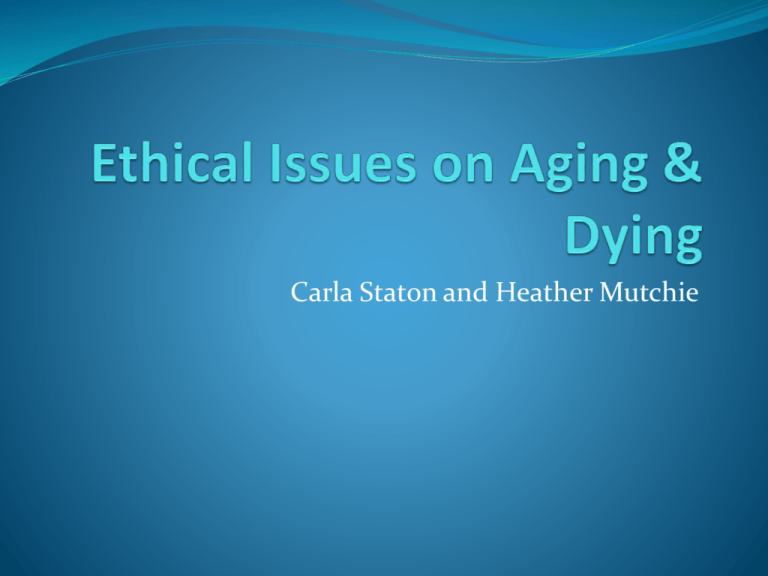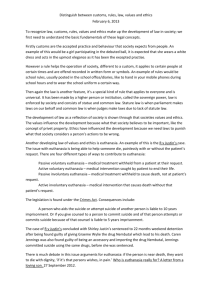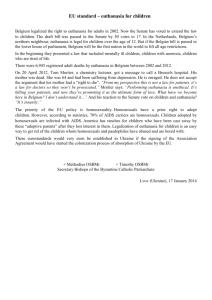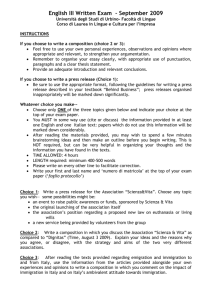Ethical Issues on Aging & Dying Student
advertisement

Carla Staton and Heather Mutchie Questions? How old is old? When have you lived a full life? What is bioethics and why has it become so important? What is the difference between active and passive euthanasia? How does having the option of euthanasia effect people? How hard should we work to keep an old person alive? Vs. keeping a young adult or child alive? Bioethics Because of increased medical technology, Bioethics has become more prominent Bioethics is the study of the interface between human values and technological advances in health and life sciences Which means, balancing between respecting a person’s freedoms and wishes and recognizing that it is impossible to to establish one solid version of the moral decision Example: the decision to turn off life support for a family member. Euthanasia Euthanasia is the practice of ending life based on mercy Euthanasia is arguably the most important issue in bioethics today and very controversial The considerations that must be made when considering euthanasia are the value and quality of a human life Most common situations where this arises are terminal illnesses and when life is sustained only by a medical machine Euthanasia Active vs. Passive Euthanasia Euthanasia can be practiced either actively or passively Active euthanasia is deliberately and intentionally ending a person’s life If the patient is unresponsive the wishes of their proxy or surrogate are considered in this matter. Passive euthanasia is the type of euthanasia that involves letting someone die Example: not preforming a surgical procedure Active Euthanasia Active Euthanasia is also commonly referred to as assisted suicide Examples are administering a drug overdose or disconnecting life support Though most Americans support actions like disconnecting life support, there is still strong moral opposition for many reasons, commonly religion Many studies have been conducted in European countries as well on this issue and found that mixed feelings are widespread Cont. A Swedish study (Valverius, Nilstun, & Nilsson, 2000) showed that increasing the education on pain relief methods decreased the amount of requests for assisted suicide Cultural Influences A person’s culture has a tremendous effect on how they view suicide Catholics view suicide as the ultimate sin Japanese believe that suicide is an honorable way to die Asian Americans have the highest rate of suicide in America and generally feel that being a burden on their families is justification Less than a third of Americans in most Ethnic groups oppose physician-assisted suicide Cultural Influences Criteria Many people accept physician-assisted suicide if a certain number of criteria are met The Oregon law makes it legal to request a lethal dose of medicine, however there are strict guidelines The Dutch Supreme Court ruled that physicians cannot be prosecuted for assisted suicide if criteria are met Oregon law is more restrictive but fundamentally similar. It requires that patient be informed that they terminally ill and of all the alternatives, the patient must be mentally competent and make a total of 2 oral requests and a written request with 15 days in between each request Impacts of Oregon Law 341 deaths in the first 10 years Psychological benefits for the patients Knowing the option is available for them to use is comforting Passive Euthanasia Withholding treatment from an already dying person is generally accepted Treating cancer in a dementia patient The moral justification is that treatment would only prolong death and extend the pain of the patient Withholding nourishment, such as food, is generally opposed by most people, even when the patient is terminally ill. U.S. Supreme Court ruled in the Nancy Cruzan case that a living will or health care power of attorney must indicate the desire to stop nourishment and that no third party has the right to do so. Passive Euthanasia Terri Schiavo Case also dealt with the form of passive euthanasia that ended nourishment through forced feeding. This case illuminated all of the moral, medical, and legal issues surrounding the topic of passive euthanasia The argument between her parents and husband showed how emotional passive euthanasia and the belief in “death with dignity” can be. End-of-Life Intentions Some of the controversy and argument around euthanasia can be avoided by making one’s intentions clearly known End-of-life intentions are generally made known through a living will. In the living will, feelings about certain treatments, diseases and life support are written down and a durable power of attorney for health care is appointed. Living wills come into importance when the person is not competent or unconscious. Living wills bring up issues that many people do not want to think about or deal with so many people avoid taking this step, making the ethics surrounding euthanasia more and more complex Passive Euthanasia Passive Euthanasia has become a controversy in more ways that one Euthanasia itself is highly debated but passive euthanasia seems to be contradictory The argument is any form of euthanasia still ends a life, which is an active process Passive Euthanasia can be accomplished two ways: withholding treatment and withholding nourishment; However, these two methods are met with differing levels of approval How old is old? Life Expectancy: age at which 50% of the population dies as of this Century: 85 years old Lifespan: maximum potential; longest lived of a population As of this Century: 120 years old All of these are great for caring for sweet old ladies BUT… Callahan’s “On Setting Limits” 1968 What is the social role of the old that we are keeping around? Being used for the effects that come with aging rather than for the unique quality of being aged Social responsibilities Theories of Aging: Disengagement and Active THEREFORE: Is it right to use public funds to prolong their lives? Arking, R, Biology of Aging Public funding for the Aged ACTIVE - The Advanced Cognitive Training for Independent and Vital Elderly REACH-Resources for Enhancing Alzheimer’s Caregiver Health Medicare – gov’t funding for medical expenses Hospice – end of life care (not exclusive to elderly) Cont’d Resource Allocation -Society as a Cell Graph from Dr. Rodney Guttmann When have you lived a ‘full’ life? Measurements of quality of life How to quantify? How could we declare a cut-off point? When can we say a life is ‘worth’ living?



